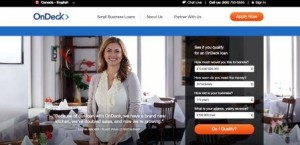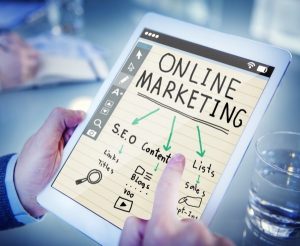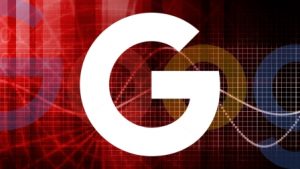You’ve heard of people who get business from LinkedIn.
Maybe you’ve even attempted to message a few people or connect with some potential leads.
But you haven’t yet cracked the code on how to sell on LinkedIn.
Good news!
In the next few paragraphs, I’m going to walk you through exactly how to use LinkedIn to support your sales strategy for the B2B market.
Grab a notepad and let’s dive in!
Why Sell on LinkedIn
With over 756 million members, LinkedIn is the biggest networking event around.
It’s available for you to access 24×7 and offers a ton of different ways for you to engage.
I’m guessing you likely have a profile on LinkedIn, as it was originally designed for job seekers.
Today, in a world where virtual selling is alive and well in the B2B market, LinkedIn is so much more.
You can access the inbox of millions of contacts, often without any investment.
Better yet, you can share your products, services and customer successes at no charge at all.
LinkedIn is key tool for social selling in today’s market.
LinkedIn as a Sales Platform
According to studies completed by LinkedIn, the people that are on their platform are ready to engage in sales conversations. A few of the key statistics were as follows:
- 76% of buyers are ready to have sales conversations on LinkedIn.
- 50% of B2B buyers turn to LinkedIn as a resource when making buying decisions.
- 62% of B2B customers respond to salespeople who connect by sharing content
These statistics might seem a bit one-sided considering they’re from LinkedIn directly, so I dug a bit deeper and found the following:
- A survey conducted by IDC identified that 75% of buyers consult social media before making a buying decision.
- The same study noted that 84% of C-suite executives consult social media before making a decision.
- A report by Demandbase stated that 65% of B2B buyers said easy-to-consume content is an important factor in buying decisions.
Needless to say, LinkedIn is a powerful sales platform, if you use it correctly.
Let’s discuss some ways to use LinkedIn to sell.
How to Sell on LinkedIn
When you start with the various points above, it’s easy to see exactly how you should use LinkedIn.
Reverting back to my earlier comment, LinkedIn is like a 24×7 networking site where you can access and engage with any of the 756 million members.
If you sell B2B, here are some of the best ways that I’ve helped my clients use LinkedIn to sell:
- Identify target companies to pursue.
- Research and identify new leads.
- Share informative content about the product or service you sell.
- Connect with decision-makers, decision-influencers and referral sources.
- Perform competitive research.
- Create and share value amongst potential buyers and existing customers.
- Reach connections that you’ve been unable to connect with otherwise.
- Follow the career path of key contacts (which can provide entryways to new companies).
- Engage in groups to share information about your products or services.
- Practice social listening with key competitors, potential buyers or your target market.
The list goes on. However, in my experience these are the most commonly practised strategies that can lead to the fastest results.
If you’re ready to start using LinkedIn to sell, let’s first visit some fundamentals to ensure you are equipped for success.
Build Your Profile
When was the last time you came across a LinkedIn profile that either had no picture or looked like an abandoned warehouse?
First impressions are everything.
The very first step then, if you want to learn how to sell on LinkedIn, is to create a professional and powerful profile.
You wouldn’t think of going to meet a buyer online or in person without first combing your hair and putting on some clean clothes, would you?
In fact, when you think about the fact that over 756 million people can view your profile, how you present yourself becomes very important!
To create a profile that is appealing and professional, put yourself in the shoes of your buyer.
What are they searching for on LinkedIn?
When they find your profile, how will you stand out from the competition?
What will be important for them to know when they do read your profile?
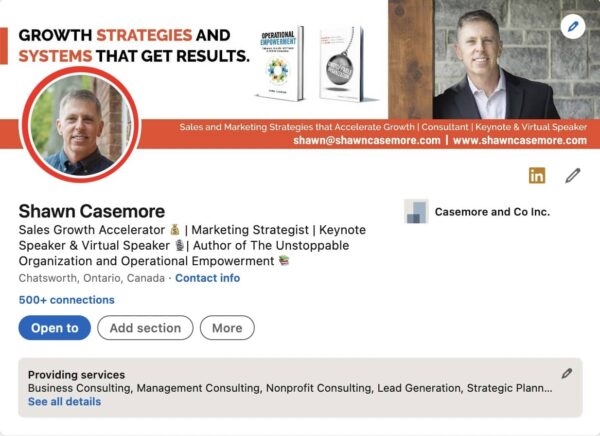
Use the following as a checklist to build a powerful profile that gets views and sparks interest in your ideal buyers.
- Professional looking head shot:
No sunglasses, beach photos or outdated photos from ten years ago.
- A profile description that speaks to your buyer:
Who are your buyers? What exactly can you help them with? Add some spice to make your description interesting enough to read.
- About Me is About Them:
Your About Me section shouldn’t talk about you. Counterintuitive, I know. Instead, it should educate the buyer on why they might want to connect with you or engage in a conversation.
Publish Content
Having a powerful and buyer-relevant profile is good, but producing content on a regular basis that helps your buyer is better.
A recent study completed by Gartner suggested that today’s buyers spend nearly 30% of their time researching a product or service online before they engage with a sales professional. For this reason, your LinkedIn profile can become a way to set yourself apart and help you, and your company, stand out as a thought leader in your industry.
If you struggle to come up with ideas on what content to produce, here are some to get you started:
- A recent study completed by your company.
- Your opinion on a recent industry event or findings of a study.
- A customer testimonial (written or video).
- A case study from a recent customer purchase.
- New information about your company’s products or services.
- Upcoming industry events you’ll be attending or participating in.
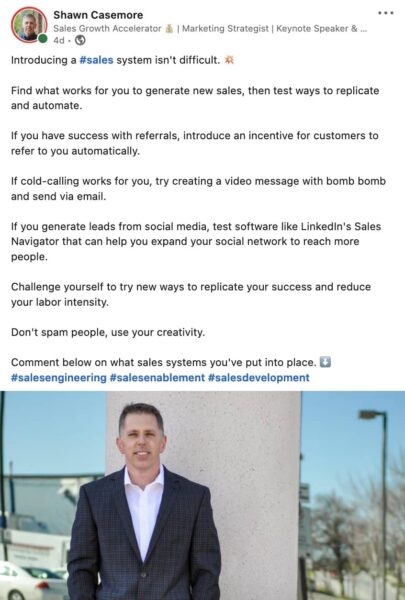
Content can also be shared in various ways on LinkedIn. You can create a post, add a video or photo, or write a long-form article.
The ideas and options for publishing content are almost endless. However, if you still struggle, simply ask yourself the following three questions:
- What content would my customers find helpful?
- What formats are they likely to prefer consuming?
- What schedule will I keep, ensuring I publish on a regular basis?
An important point to mention – make sure you keep it professional. LinkedIn is not the place for beach photos unless there is an important message behind the photo that supports your personal brand and your company’s (i.e., a company picnic or supplier day at the beach).
Analyze Your Statistics
It’s difficult to improve if you aren’t aware of your statistics, and LinkedIn provides insights that can be extremely helpful.
Some of the basic statistics you can access include:
- Who has viewed your profile
- Number of people following you
- Number of people who have viewed your content
The majority of these statistics can be viewed either on your posts or in your network area. To dive deeper, you can select Updates under the Analytics tab and view levels of engagement at greater depths.
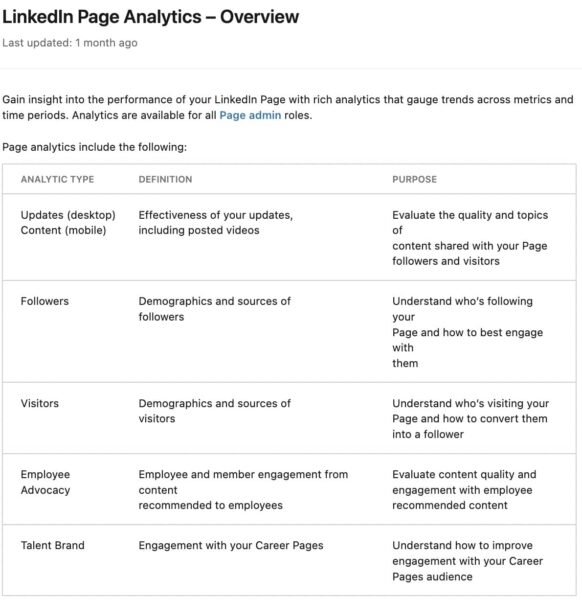
If you want to dive deeper into analytics, you may find that you have to upgrade your plan. LinkedIn offers several plans, depending on your goals.
Make sure if you are going to upgrade your plan, you test and use the various features. LinkedIn will often offer a free trial period for you to test out their plans, so use the time wisely.
Join Industry and Sector Groups
Admittedly I haven’t participated in many groups over the years. That said, groups can be a great way to practise social listening, share your expertise and learn about industry events and challenges.
Some of the more common ways to use groups include:
- What are your ideal or target buyers talking about?
- What ideas can you generate for content based on questions that are being asked?
- What questions can you respond to and generate awareness of your expertise?
Some groups will also allow you the opportunity to publish and post content, which can quickly expand your network, creating new connections and opportunities to begin conversations.
Connect with Your Buyers

This is one of the most important aspects to LinkedIn, in my opinion. When you connect with your buyers, you unlock the opportunity to not only get their attention with your content but to engage in a conversation through LinkedIn messaging.
In my experience, the level of engagement on LinkedIn (that is, accepting connections and responding to messages) can be very high, upwards of 60-70%. But the drivers to achieving these levels of engagement are in following the best practices I’ve mentioned above.
Many potential connections will visit your profile when you reach out to connect, so having a professional profile with relevant and helpful content is a must.
Personalizing each connection is also important. On mobile, when you click the “connect” button an invite is sent with the standard LinkedIn message – not engaging.
If you send a connection request through your laptop or desktop, you have the option to add a note.
Use this method and make a personalized note for each and every connection.
This may seem like a lot of work, but if you met with someone in person, would you say, “it’s nice to connect,” or would you personalize each introduction? The latter is more effective.
Do’s and Don’ts
We’ve discussed some do’s and don’ts, but it’s important to highlight a few here to be sure you have the most success with LinkedIn possible.
Do’s:
- Have a professional profile.
- Publish relevant content on a regular basis.
- Reach out to connect with your potential buyers – personalize each message.
- Join relevant groups and join in conversations to highlight your expertise.
- Send messages to contacts to offer insights or support.
Don’ts:
- Send blanket connection requests.
- Use profanity anywhere on LinkedIn.
- Engage in debates (unless it’s part of the personal brand you’re trying to create).
- Join every group you can. Instead, be strategic about where you engage.
- Go silent for extended periods of time. The key to LinkedIn is consistency.
Above all, think of LinkedIn as one big networking event. Be professional, reach out to engage with those of interest, and let your personality shine through.
Selling Using LinkedIn
LinkedIn is a powerful tool for anyone in sales.
But like every tool, you need to know how to use it.
By starting with a professional profile and building valuable content, you can attract your ideal buyers to you.
Add to this some strategic outreach, and your network will grow exponentially.
Digital & Social Articles on Business 2 Community
(68)
Report Post
